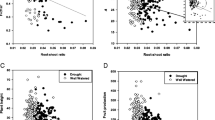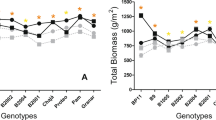Summary
Water is often the most limiting factor to winter wheat (Triticum aestivum L.) production in the southern Great Plains of the U.S.A., yet the lack of reliable screening criteria has precluded direct selection for drought resistance in breeding programs. Previous work showed that leaf relative water content (RWC) was highly heritable when measured under field-drought conditions, but its adoption as a screening tool for yield improvement requires further investigation of the genetic relationship between grain yield and RWC. Plants representing high and low yield potential under drought stress, and a random group of plants, were selected from an F2 population having the pedigree, TAM W-101/Sturdy. Two sets of entries, each comprised of the two parents and 24 F2-derived lines, were evaluated under a rainshelter in the F3 (1986) and F4 (1987) generations to determine differences in leaf RWC during reproductive development. One set of entries did not receive any water after the jointing stage, and the other set was grown under well-watered conditions. A positive relationship was observed between grain yield and RWC measured during anthesis and mid-grain fill, as the high-yield selections maintained a significantly higher RWC than the low-yield selections. Grain yield and RWC were also positively associated among random selections segregating for both traits. Subsequent adjustment of genotype means for differences in reproductive development at time of sampling underscored the need to consider differences in maturity when RWC is the selection criterion.
Similar content being viewed by others
References
Begg J.E. & N.C. Turner, 1976. Crop water deficits. Adv. Agron. 28: 161–217.
Bennett J.M., T.R. Sinclair, R.C. Muchow & S.R. Costello, 1987. Dependence of stomatal conductance on leaf water potential, turgor potential, and relative water content in field-grown soybean and maize. Crop Sci. 27: 984–990.
Blum A., 1985. Breeding crop varieties for stress environments. CRC Crit. Rev. Plant. Sci. 2: 199–239.
CarterJr. T.E. & R.P. Patterson, 1985. Use of relative water content as a selection tool for drought tolerance in soybean, p. 77. In: Agronomy Abstracts. Crop Sci. Soc. America, Madison, WI.
Clarke J.M. & T.N. McCaig, 1982. Evaluation of techniques for screening for drought resistance in wheat. Crop Sci. 22: 503–506.
Cox T.S., J.P. Shroyer, L. Ben-Hui, R.G. Sears & T.J. Martin, 1988. Genetic improvement in agronomic traits of hard red winter wheat cultivars from 1919 to 1987. Crop Sci. 28: 756–760.
Feyerherm A.M., K.E. Kemp & G.M. Paulsen, 1988. Wheat yield analysis in relation to advancing technology in the midwest United States. Agron. J. 80: 998–1001.
Feyerherm A.M., G.M. Paulsen & J.L. Sebaugh, 1984. Contribution of genetic improvement to recent wheat yield increases in the USA. Agron. J. 76: 985–990.
Johnson R.C., H.T. Nguyen & L.I. Croy, 1984. Osmotic adjustment and solute accumulation in two wheat genotypes differing in drought resistance. Crop Sci. 24: 957–962.
Matin M.A., J.H. Brown & H. Ferguson, 1989. Leaf water potential, relative water content, and diffusive resistance as screening techniques for drought resistance in barley. Agron. J. 81: 100–105.
SAS Institute Inc., 1985. SAS user's guide: Statistics. 5th ed. SAS Institute Inc., Cary, NC.
Schmidt, J.W., 1984. Genetic contributions to yield gains in wheat, pp. 89–101. In: W.R. Fehr (Ed.) Genetic Contributions to Yield Gains of Five Major Crop Plants. Crop Sci. Soc. America, Spec. Publ. 7, Madison, WI.
Schonfeld M.A., R.C. Johnson, B.F. Carver & D.W. Mornhinweg, 1988. Water relations in winter wheat as drought resistance indicators. Crop Sci. 28: 526–531.
Simmons S.R., 1987. Growth, development, and physiology, pp. 77–113. In: E.G. Heyne (Ed.), Wheat & Wheat Improvement. 2nd edition. Crop Sci. Soc. America, Madison, WI.
Sinclair T.R. & M.M. Ludlow, 1985. Who taught plants thermodynamics? The unfulfilled potential of plant water potential. Aust. J. Plant Physiol. 12: 213–217.
Tadasse N., D. Reeves, T. Schumacher & L. Hall, 1988. Genetic variation of oat (Avena sativa L.) characters related to water-stress tolerance, p. 97. In: Agronomy Abstracts. Crop. Sci. Soc. America, Madison, WI.
Wardlaw I.F., 1966. The effect of water stress on translocation in relation to photosynthesis and growth. I. Effect during grain development in wheat. Aust. J. Biol. Sci. 20: 25–39.
Winter S.R., J.T. Musick & K.B. Porter, 1988. Evaluation of screening techniques for breeding drought-resistant winter wheat. Crop Sci. 28: 512–516.
Author information
Authors and Affiliations
Rights and permissions
About this article
Cite this article
Tahara, M., Carver, B.F., Johnson, R.C. et al. Relationship between relative water content during reproductive development and winter wheat grain yield. Euphytica 49, 255–262 (1990). https://doi.org/10.1007/BF00036297
Received:
Accepted:
Issue Date:
DOI: https://doi.org/10.1007/BF00036297




